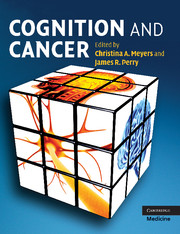Book contents
- Frontmatter
- Contents
- List of contributors
- Preface
- Section 1 Cognition and the brain: measurement, tools, and interpretation
- Section 2 Effects of cancer and cancer treatment on cognition
- 7 Biological bases of radiation injury to the brain
- 8 Cognitive dysfunction related to chemotherapy and biological response modifiers
- 9 Effect of hormones and hormonal treatment on cognition
- 10 Low-grade gliomas
- 11 High-grade gliomas
- 12 Brain metastases
- 13 Primary central nervous system lymphoma
- 14 Childhood brain tumors
- 15 Neurofibromatosis
- 16 Hematological malignancies
- 17 Paraneoplastic disorders
- 18 Symptomatic therapies and supportive care issues
- 19 Animal models and cancer-related symptoms
- Section 3 Interventions and implications for clinical trials
- Index
- Plate section
- References
11 - High-grade gliomas
Published online by Cambridge University Press: 13 August 2009
- Frontmatter
- Contents
- List of contributors
- Preface
- Section 1 Cognition and the brain: measurement, tools, and interpretation
- Section 2 Effects of cancer and cancer treatment on cognition
- 7 Biological bases of radiation injury to the brain
- 8 Cognitive dysfunction related to chemotherapy and biological response modifiers
- 9 Effect of hormones and hormonal treatment on cognition
- 10 Low-grade gliomas
- 11 High-grade gliomas
- 12 Brain metastases
- 13 Primary central nervous system lymphoma
- 14 Childhood brain tumors
- 15 Neurofibromatosis
- 16 Hematological malignancies
- 17 Paraneoplastic disorders
- 18 Symptomatic therapies and supportive care issues
- 19 Animal models and cancer-related symptoms
- Section 3 Interventions and implications for clinical trials
- Index
- Plate section
- References
Summary
Introduction
After more than 30 years of intensive clinical and laboratory research, high-grade gliomas (HGG) [glioblastoma multiforme (GBM), anaplastic astrocytoma (AAs), anaplastic oligodendroglioma, and anaplastic mixed glioma] retain a well-deserved reputation for poor response to therapy, rapid tumor recurrence, and short overall survival. Currently available treatments, including surgery, cranial irradiation, and chemotherapy, extend survival measurably, but are almost always non-curative, and are associated with substantial toxicity. In this context, maintaining good quality of life has assumed an increasingly prominent role in selecting treatments and in designing clinical trials (Report of the Brain Tumor Progress Review Group, 2005; Taphoorn et al., 2005), and the paradigm of compressing morbidity and “rectangularizing” the survival curve (Fries, 1980) is increasingly seen as the central goal of cancer therapy (Figure 11.1).
Traditionally, myelosuppression and its attendant problems have been the dose-limiting and most important toxicities of radiation and chemotherapy. In the late 1990s and early 2000s, however, the availability of colony stimulating factors, and dramatic improvements in transfusion medicine, antibiotic therapy, and supportive care made the bone marrow more robust. Today, a strong case can be made that the nervous system has replaced the bone marrow as the most important dose-limiting end organ for cancer therapy in general, and for therapy directed at central nervous system tumors in particular. For the large number of children (Bhat et al., 2005; Lannering et al., 1990; Packer et al., 2003) and for the still small but growing number of adult long-term survivors of malignant primary brain tumors, the nervous system rather than the hematopoietic system more frequently affects the quality of survival and the economic productivity of survivors.
- Type
- Chapter
- Information
- Cognition and Cancer , pp. 156 - 169Publisher: Cambridge University PressPrint publication year: 2008



